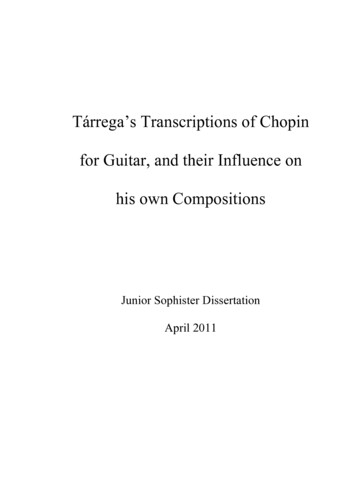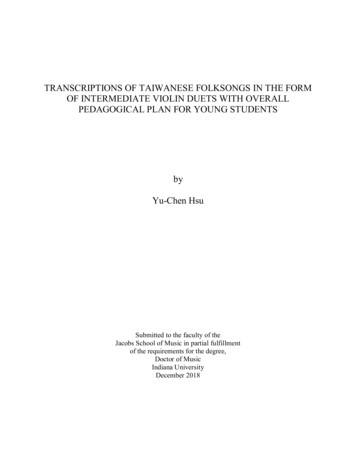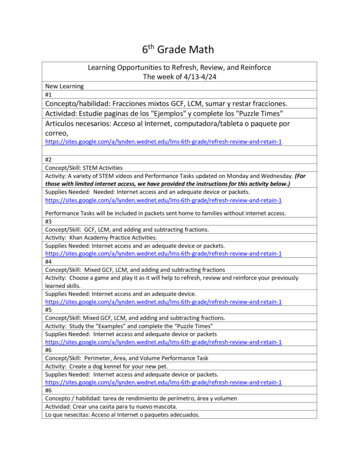
Transcription
Tárrega’s Transcriptions of Chopinfor Guitar, and their Influence onhis own CompositionsJunior Sophister DissertationApril 2011
AbstractFrancisco Tárrega is considered one of the most important figures in the history ofthe guitar, his compositions retaining their place in the repertoire over 100 yearssince his death. These compositions mark a new style in guitar composition, differingvastly from the works of the masters of the guitar before his time.Tárrega’s musical training is discussed in a brief biography, which had asignificant role in the development of his own, unique style of guitar composition.His method of transcription for the guitar, in which he arranged works by composerssuch as Bach, Beethoven, Schumann, Schubert, and specifically Chopin, isdiscussed, as is his ability to arrange these works for the guitar in a simple, yet ofteneffective way. His transcriptions of Chopin’s Mazurka, Op.33 no.1, and Prelude, Op.28 no.7, are discussed, and the effective transfer of these pieces to the guitar, usingcomparisons between a transposed version of the piano score and the guitararrangement.The influence of this musical education and transcriptions are discussed inChapter III. This discussion is limited specifically to the influence of Chopin,considered to have had the most significant influence on Tárrega, who composedwaltzes, polkas, and mazurkas in his own unique style, while still showing influencefrom Chopin’s use of these dance forms. The comparison is shown throughconnections between the mazurkas of both composers. Tárrega’s mazurka Marieta isdiscussed, along with Sueño, ‘Mazurka in G’ and Adelita.
iContentsList of Musical ExamplesiiIntroduction1Chapter I: A Short Biography of Francisco Tárrega3Chapter II: Tárrega’s Transcriptions7Chapter III: Tárrega’s Compositions15Conclusion22Appendix24Bibliography39
iiList of Examples1.1A brief timeline showing important figures in the history of theclassical guitar.12.1A Tárrega concert programme from 13th July 1889.72.2A Tárrega concert programme from 10th May 1888.82.3A Tárrega concert programme from Madrid, 1904.92.4A comparison of a transposed version of Chopin’s Op.33 no.1, andTárrega’s transcription for the guitar.112.5A comparison of a transposed version of Chopin’s Prelude no.7, andTárrega’s transcription for the guitar.133.1Marieta, bars 1–5.163.2Marieta, melody of bars 1–2.163.3Marieta, melody of bars 2–4.173.4Marieta, Simplified Melody of bars 1–4.173.5Marieta, bars 6–7.183.6Marieta, bars 9–11.183.7Marieta, Bars 17–19.193.8Sueño, bars 1–8.20
iii3.9Chopin’s Mazurka Op.7 no.1, bars 1–10.203.10‘Mazurka in G’, bars 1–2.213.11Adelita, bars 1–3.21
1IntroductionFrancisco Tárrega, often called the ‘father of the modern classical guitar,’1 had alarge influence on the pedagogy and repertoire of the instrument, although the extentof this importance has often been debated. He is often credited with keeping theinstrument alive in his native Spain, following a decline in popularity of theinstrument in Europe in the 1850s.2Example 1.1: A brief timeline showing important figures in the history of theclassical guitar1Tony Skinner, Raymond Burley and Amanda Cook, London College of Music-Classical GuitarGrade 8 (Sussex: Registry Publications, 2008), 11.2This decline in popularity was a result of a number of factors. Along with the deaths of Sor andGuiliani, composers of the time felt the instrument unable to deal with the increasing chromaticism inmusic. ‘Central to the issue of the instruments decline was the nature of music itself which becameever more chromatic, harmonically experimental and increasingly difficult for all but the mostaccomplished guitarists to exploit, as opposed to a pianist of even average ability.’ (Simon Wynberg,Marco Aurelio Zani De Ferranti, Guitarist (1801–1878), (Heidelberg: Chanterelle, 1989), 61.) Theweak sonority of the instrument was also an important factor in this decline. This was taken up byBerlioz in his treatise on orchestration: ‘Its feeble amount of sonorousness, which does not admit ofits being united instruments, or with many voices possessed but of ordinary brilliancy, is doubtless thecause of this.’ (Hector Berlioz, Grand Traité D'instrumentation Et D'orchestration Modernes, HughMacdonald (ed. and trans.) (Cambridge: Cambridge University Press, 2002), 66–67.) Luthiers such asTorres and Ramírez addressed this problem during the 20th Century.A complete history of the classical guitar is beyond the scope of this dissertation. For an introductionsee – Graham Wade, A Concise History of the Classic Guitar (Pacific: Mel Bay, 2001).
2Along with his transcriptions, Tárrega wrote over 100 compositions,encompassing a series of préludes and études, several works based on dance formssuch as waltzes, mazurkas, polkas, minuets, gavottes, and some larger scale workssuch as his Gran Jota, the famous tremolo work Recuerdos de Alhambra, his GranVals (from which the Nokia tune originates) and Capricho árabe. His developmentof a unique melodic style on the instrument has several points of influence: mainlythat of the guitar he played, created by luthier Antonio de Torres, and the influenceof the piano music of the 19th century, specifically that of Frédéric Chopin.Tárrega’s musical education, beginning at an early age, played a great role inthe shaping of his compositions, which in turn have influenced guitarists since hisdeath. In a short biographical summary, significant points during the guitarists life,specifically those which concern themselves with his development as a musician,such as his eyesight problems, his early teachers, his training in piano and at theConservatoire in Madrid, as well his acquisition of his first Torres guitar, have beenhighlighted.3 It was this musical education that resulted in Tárrega’s transcriptionsfor the guitar, arranging works by composers such as Chopin, Schumann, Beethoven,Bach, Mozart and many others. These transcriptions and his exposure to the music ofthese composers bore a significant influence on Tárrega’s own compositions. 4 It wasundoubtedly the music of Frédéric Chopin that was most influential, with Tárregacomposing in forms similar to those used by Chopin, along with developing amelodic style on the guitar that draws influence from the melodies and style ofornamentation used by Chopin at the piano.3For further reading on the life of Tárrega, see Emilio Pujol, Tárrega–Ensayo Bíográfico, PatrickBurns (ed.), Jessica Burns, (trans.), Kindle edn (Chilitones Music Publishing, 2009), and Adrian Rius,Francisco Tárrega 1852–1909 Biography, Liuguisticos, Dixon Servicios (trans.) (Valencia: PILES,Editorial de Música S.A., 2006).4Graham Wade, Francisco Tárrega His Life and Music (DVD, Pacific: Mel Bay, 2008).
3Chapter IA Short Biography of Francisco TárregaTárrega was born on Sunday, November 21st, 1852, in the Spanish town ofVillarreal. His father, also named Francisco, worked as a caretaker in the town, forwhich he earned a small salary. His mother, Antonia, helped to support the home byserving as an errand-runner for the nuns at San Pascual’s convent. Because of herjob, she had to hire a nursemaid to look after the young boy, nicknamed Quiquet (theSpanish for Frank).5 It was under the care of this nursemaid that Tárrega contracted asevere infection in his eyes.6 The incident caused a strange ailment to settle on hiseyelids, and he had to undergo repeated surgery throughout his life, without everfinding any relief or cure.7 This, combined with his nearsightedness, resulted inTárrega having extremely limited eyesight throughout his life. As a result, his father,who was also nearly blind, encouraged a musical education in the young Tárrega,which he saw as a possible method of survival, should his son’s eyesight worsen.8Francisco the elder gave his son basic lessons in guitar and music theory, andhoped his son would later study the piano or the violin (seen then in Spain, and stillin most countries, as more elevated instruments).9 Once Tárrega had surpassed hisfather, he was enrolled in classes with the blind pianist, El Ciego Ruiz, who taught5Emilio Pujol, The Biography of Francisco Tárrega, Burns, Locations 209–25.Adrian Rius, Francisco Tárrega 1852–1909 Biography, Liuguisticos, Dixon Servicios (trans.)(Valencia: PILES, Editorial de Música S.A., 2006), 18.7Emilio Pujol, The Biography of Francisco Tárrega, Locations 209–25.8Ibid., Locations 278–97.9Ibid., Locations 278–97.6
4sol-fa and piano.10 He also continued guitar lessons under a local musician,reportedly the best guitarist in Castellón, but it did not take long for Tárrega tooutgrow his new teacher. He was also taught briefly by the renowned guitarist, JulianArcas, who agreed to tutor Tárrega after hearing him play, following a concert inCastellón.11As Tárrega grew older, he began to support his family through a seriesconcerts, performing at local cafés, casinos, and private residences.12 He also workedfor a time as a pianist in the casino of Burriana, the sister city of Villarreal. EmilioPujol, in his biography of his former teacher, states that Tárrega would freely playthe studies of Aguado, along with the works of Arcas on the piano during this time.13His fame as a gifted guitarist and pianist soon began to spread, and resulted in acircle of friends and admirers surrounding the 17 year–old Tárrega, resulting in hismeeting with his first patron, Don Antonio Cánesa Mendayas.14 It was Cánesa whoembarked on the trip with Tárrega to the legendary guitar maker, Antonio de Torres,after hearing Julian Arcas perform on one of his instruments. Pujol describes themeeting of the luthier and the young maestro in his essay:These unknown callers didn’t look to Torres like anyone who would beinterested in a high-priced guitar and he consequently showed them one thatwas just fair. Tárrega began by examining the instrument and proceeded toplay a series of chords and passages to prove the guitar’s quality. Torres,besides being a luthier, was also a guitarist of recognised ability and finemusical perception, and he was soon aware that this was an exceptionalguitarist before him. His surprise and admiration grew until he said: ‘Wait;this guitar is not for you.’ He went back to the back of the shop and a fewminutes later returned with a beautiful instrument, which he had made withan artist’s love for his own use. Putting it into Tárrega’s hands he said: ‘Thisis the guitar you deserve.’1510Adrian Rius, Francisco Tárrega 1852–1909 Biography, 20.Ibid., 21.12Ibid., 29.13Emilio Pujol, The Biography of Francisco Tárrega, Locations 571–88.14Adrian Rius, Francisco Tárrega 1852–1909 Biography, 30–31.15Emilio Pujol, The Biography of Francisco Tárrega, Locations 606–22.11
5This was the guitar played by Tárrega until 1889, when he switched to a newerTorres instrument, which he played until his death in 1909. The Torres guitar shouldbe considered a significant influence on Tárrega’s performance style andcompositions. Under the suggestion of Arcas, Torres had experimented with newmethods of guitar construction, varying bracing patterns and enlarged bodies,resulting in an instrument of greater volume and resonance.16 These prototypeseventually resulted in the classical guitar as it is known today, and allowed playersand composers to push the boundaries of the instrument both technically andexpressively.17 In his foreword to José Romanillos’s book on Torres, Julian Breamstates that, while Tárrega was a considerable artist who played a revolutionary role inthe development of the instrument, ‘his contribution without the Torres guitar wouldhave been minimal.’18After a short time in the Spanish Military, Tárrega entered the Madridconservatory in 1874, and remained there for a year, where he took courses in sol-fa,piano and harmony.19 The director of the conservatory, Emilio Arrieta, invited him toperform for the other professors in a private concert. While Tárrega impressedArrieta, even improvising on themes suggested by his audience, it was recommendedthat someone of such talent should apply themselves to the piano, as it would surelybring more distinction.20 However, Arrieta changed his mind upon his attendance at aconcert in the Alhambra theatre, where Tárrega performed alongside other great16John Managan, 'Chopin for the Guitar: A Newly Discovered Transcription by Francisco Tárrega,'Guitar Review/109 (1997): 2–11, 2.17Ibid., 2.18Julian Bream, ‘Foreword’ in Antonio De Torres: Guitar Maker–His Life and Work, José L.Romanillos (Longmead, Shaftesbury and Dorset: Element Books Ltd., 1987), vii–ix.19Emilio Pujol, The Biography of Francisco Tárrega, Locations 745–60.20Ibid., Locations 761–78.
6artists such as Albéniz, Chueca and Chapí.21 Following a standing ovation, Ariettapraised him, stating: ‘The guitar needs you; you were born for it.’22 While the pianohad been imposed on him for musical training, Tárrega at this point chose to dedicatehis life to the guitar, a new medium of expression to convey his sensibility.23However, it was his training in the piano and harmony which allowed him to beginhis transcriptions for the guitar, along with influencing his own compositions.24Tárrega made several trips outside of Spain during his lifetime, mainly toFrance, but also ventured as far as Italy and England. He never wished to travelfurther, despite the invitations, and even returned to Spain early from his trip toEngland. He was a man in love with his homeland, much preferring to sit in his roomand play for his family or visitors, than travel and play to large halls or kings indistant lands. Apelles Mestres, the Spanish writer and poet, remarked that:Tárrega deserved to be called the ‘king of the guitar’ all over the world. Andwhy wasn’t he? Because he cared nothing for public acclaim nor fame, andeven less for money he could get. It could be said that he never left home, andhardly went anywhere.25Despite a stroke in 1906, Tárrega recovered to give some small intimate con
Vals (from which the Nokia tune originates) and Capricho árabe. His development of a unique melodic style on the instrument has several points of influence: mainly that of the guitar he played, created by luthier Antonio de Torres, and the influence of the piano music of the 19th century, specifically that of Frédéric Chopin.











